Patching Template Files
The Template Patch Packager Wizard allows you to make changes to templates that have already been packaged and distributed. The wizard detects which files have been added, removed, or changed since the installation and updates the template package accordingly.
Complete the steps below to patch a template:
Global Options
The Global Options page specifies how the Template Patch Installer wizard will look and behave.
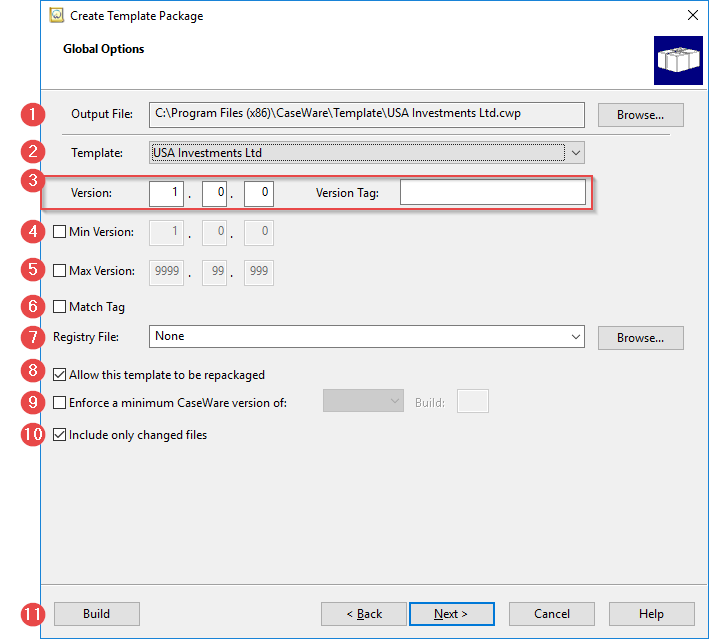
| Number | Screen Element | Description |
|
|
Output File |
Displays the file path where the packaged template will be located. Click Browse to choose a different location and specify a File name. |
|
|
Template |
Click to select the template you want to patch. |
|
|
Version |
Specifies a version number for the package. Enter version numbers and a version tag to keep track of different versions. The version number is added to the registry during the installation of the template. The version information is used to determine which version to overwrite when you are patching a template. |
|
|
Min Version |
The minimum version number the template can have and still have files overwritten by the patch. A patch with a Min Version of 2.0.0 would overrite a template with version number 2.5.0, but not 1.0.0. |
|
|
Max Version |
The maximum version number the template can have and still have files overwritten by the patch. A patch with a Max Version of 2.0.0 would overrite a template with version number 1.5.0, but not 3.0.0. |
|
|
Match Tag |
If checked, the template will only be applied to a template which has a matching version tag. For example, a patch with the version tag Rev A could only be applied to a template with a version tag Rev A. If unchecked, the patch will apply its version tag to the template. For example, if a patch with a version tag of Rev A were applied to a template without a version tag, the patched template would then have the version tag Rev A. Note: Revision tags are case sensitive. |
|
|
Registry File | Use the drop-down menu or click Browse to select a registry file. Include a registry file if the patch requires registry changes. |
|
|
Allow this Template to be Repackaged |
Select to allow the template to be repackaged. Note: Preventing templates from being repackaged on a machine where the template is already installed is a known security measure. |
|
|
Enforce a minimum CaseWare version of |
Select to limit the template to be used with a minimum version of CaseWare Working Papers. If this check box is selected, use the drop-down list to select a version and enter a build number in the Build field to specify the minimum version of Working Papers and build number for this template to be used in. |
|
|
Include only changed files | If selected, only files that have been changed are included with the patch. Otherwise, all files are included. |
|
|
Build | Click to build the template package without continuing through the wizard. |
Branding Options
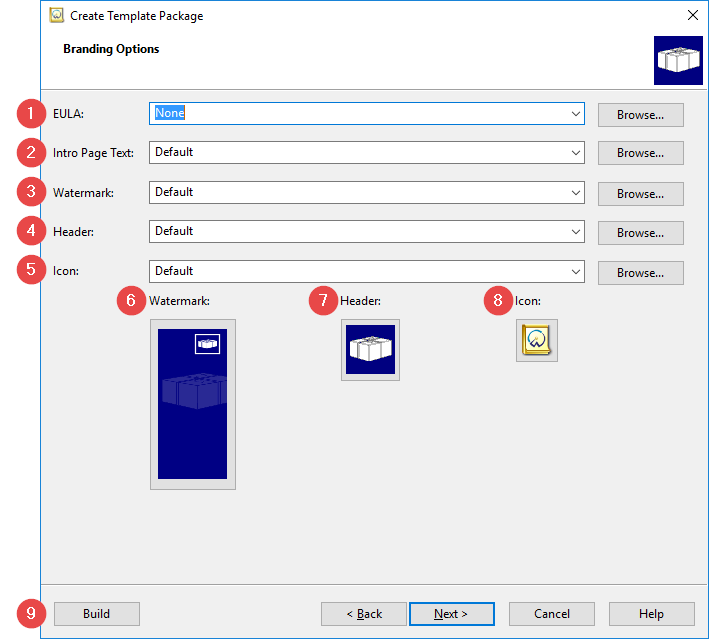
| Number | Screen Element | Description |
|
|
EULA |
Include an End User License Agreement (EULA) that the user must accept before the installation can proceed. You can enter the file name, use the drop-down list, or click Browse to select an *.rtf or *.txt file. |
|
|
Intro Page Text |
Include text to be displayed on the first page of the installation wizard. You can enter the file name, use the drop-down list, or click Browse to select an *.rtf or *.txt file. |
|
|
Watermark |
Include a custom image to show on the left side of the first page of the installation wizard. You can enter the file name, use the drop-down, or click Browse to select a *.bmp file. For optimum resolution, the size of the watermark graphic must be 165x450 pixels. |
|
|
Header |
Include a custom image in the header of the installation wizard. You can enter the file path, use the drop-down list, or click Browse to select an *.rtf or *.txt file. |
|
|
Icon |
Include a custom icon to represent a template in the Templates dialog. You can enter a file path, use the drop-down list, or click Browse to select a *.bmp or *.ico file. A preview is shown in the Icon box. |
|
|
Watermark | A preview of the watermark to be included is shown. Click the image to choose a new one. |
|
|
Header |
A preview of the header to be included is shown. Click the image to choose a new one. |
|
|
Icon |
A preview of the icon to be included is shown. Click the image to choose a new one. |
|
|
Build |
Click to build the template package without continuing through the wizard. |
Layout

| Number | Screen Element | Description |
|
|
Change Source |
Click this button to select another file path where layouts are located. |
|
|
Layouts |
Select the check box beside each layout you want to include in the template package. Note: If the selected layout requires dependent layouts, those layouts are automatically included, even if you haven't selected them. The next time you package template files, the layouts previously selected and their dependent layouts are automatically selected and are always included in the package. |
|
|
Overwrite Actions |
Select an option to overwrite existing layouts.
|
|
|
Build |
Click to build the template package without continuing through the wizard. |
Specify Files
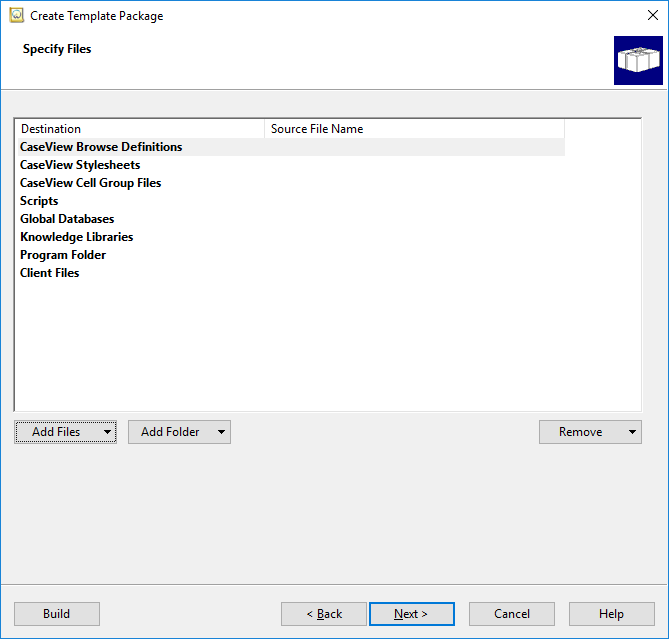
| Preview | Screen Element | Description | ||||||||||||||||

|
Add Files | Click to include individual files. | ||||||||||||||||

|
Add Folder |
Click to include folders. Including a folder will include all of the files within the folder. |
||||||||||||||||

|
Allow user to specify Knowledge Library extract path |
Select this option to provide the user the option to install knowledge library files in a location other than the program folder. Note: This option only appears when Knowledge Libraries is selected. |
||||||||||||||||

|
Build |
Click to build the template package without continuing through the wizard. |
||||||||||||||||

|
Create shortcut on desktop |
Select this option to add a desktop shortcut for the file. Note: This option only appears when an individual file added with Add Files is selected. |
||||||||||||||||
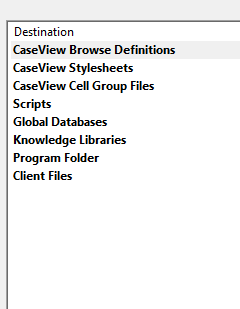
|
Destination |
This column specifies the files to be included. The files selected for each category will be installed to the following locations:
|
||||||||||||||||

|
File Overwrite Actions |
Select an option to determine how existing files will be overwritten:
Note: This option only appears when an individual file is selected, or when a folder is selected and Merge folder contentsis selected from the Folder Merge Actions drop down menu. |
||||||||||||||||

|
Folder Merge Actions |
Select an option to determine merge behavior for existing folders:
|
||||||||||||||||

|
Register this COM file during installation |
Select this option if you want to deliver *.exe or *.dll files to be used by scripting. Note: This option only appears when an .exe or .dll file added with Add Files is selected. |
||||||||||||||||

|
Remove |
Click to remove a single file or all files. |
||||||||||||||||
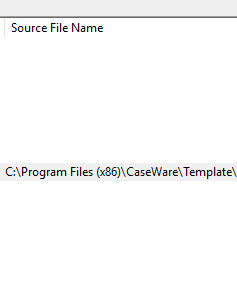
|
Source File Name |
This column specifies the file path of the files to be included. |
External Programs
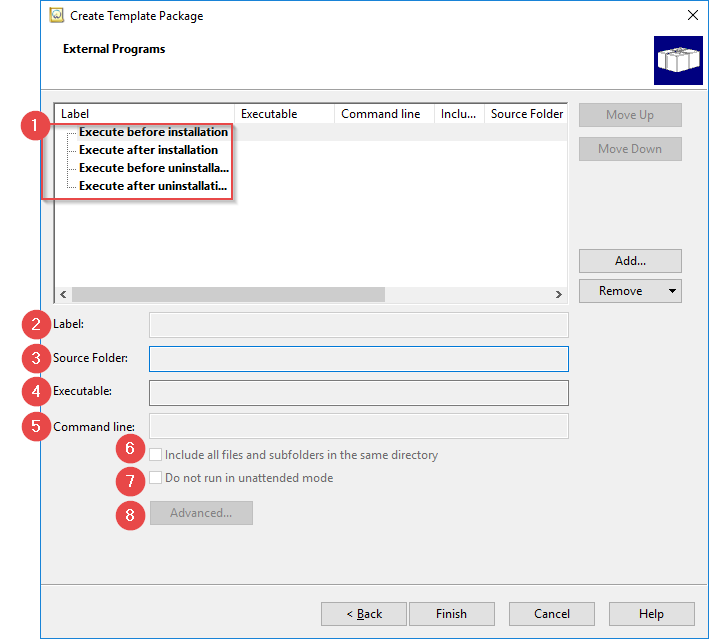
| Number | Screen Element | Description |
|
|
Execute |
|
|
|
Label |
This field specifies a unique label assigned to each application. |
|
|
Source Folder |
This field specifies the file path of the application. |
|
|
Executable |
This field specifies the name of the application. |
|
|
Command line |
This field specifies additional parameters that are needed to run the executable. The additional parameters are passed to the Template Installer which will run the executable and append the command line parameter. |
|
|
Include all files and subfolders in the same directory |
Select this option to include all supporting files needed for installing the application. Note: Use this check box with caution; if, for example, you put the executable on your C: drive and select this check box, then all files on your C: drive are included in the template package. |
|
|
Do not run in unattended mode |
Choose this option to prevent the selected executable from running in unattended mode. |
|
|
Advanced... |
See Advanced Options Dialog for more information. |
Finish
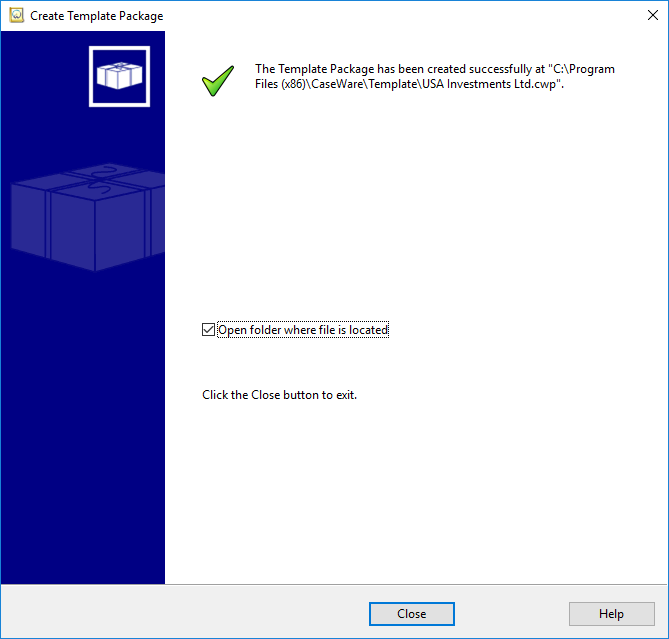
This will confirm whether the template patch package was successfully or unsuccessfully created. If successful, the file path where the package was created is displayed.
After patching the template package, install the patch as you would install a template package.




